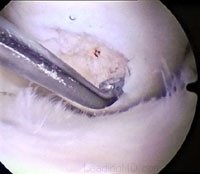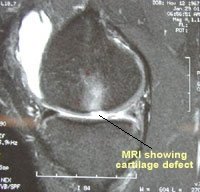Microfracture is a surgical technique that has been developed to treat chondral defects, which are damaged areas of articular cartilage of the knee. It is a common procedure used to treat patients with full thickness damage to the articular cartilage that goes all the way down to the bone.
This arthroscopic procedure was first introduced about 20 years ago as a treatment method that uses the body's own healing abilities and provides an enriched environment for tissue regeneration on the chondral surface.
Since its development, the microfracture procedure has been used by its originator to treat more than 2000 patients. Of these patients, 75 to 80% experienced significant pain relief and improvement in the ability to perform daily activities and participate in sports. Fifteen percent noticed no change, and five percent continued to have joint deterioration.
Overview

What are the signs and symptoms of an articular cartilage injury that may be treated with the microfracture technique?
- Intermittent swelling - Loose fragments floating in the knee can cause swelling to occur.
- Pain - Pain with prolonged walking or climbing stairs can occur.
- Giving way - The knee may occasionally buckle or give way when weight is placed upon it.
- Locking or catching - Loose, floating pieces of cartilage may catch in the joint as it bends, causing the knee to lock or have limited motion.
- Noise - The knee may make noise (called crepitus) during motion, especially if the cartilage on the back of the kneecap is damaged. This noise is often described as "snap, crackle, and pop".

After articular cartilage damage has been diagnosed, what factors are indications for microfracture?
The general indications for microfracture are:
- The patient has a full-thickness defect (loss of articular cartilage down to the bone) in either a weightbearing area between the femur and tibia or in an area of contact between the back of the patella and the groove it slides in.
- The patient has unstable cartilage covering the underlying bone.
- The patient has degenerative changes in a knee that is normally aligned.
Important factors to consider for use of the microfracture procedure are:
- The patient's age (as a relative indication)
- The patient's activity level
- Whether or not the patient has acceptable alignment of the knee. "Knock-kneed" or "bowlegged" patients may not be good cadidates for this procedure.
When is microfracture not recommended for a patient?
Microfracture is not recommended when:
- the patient's knee is poorly aligned.
- the patient's chondral defect is not all the way through the full thickness of the cartilage.
- the patient is not willing to follow a strict and rigorous rehabilitation protocol.
- the patient is older (generally over 65) and might have difficulty with crutch use and the rehabilitation process.
- the patient has disease-induced arthritis, cartilage disease, or any disease affecting the immune system (e.g. rheumatoid arthritis).
The Surgical Procedure: Microfracture
The microfracture procedure is done arthroscopically. The surgeon visually assesses the defect and performs the procedure using special instruments that are inserted through three small incisions on the knee. After assessing the cartilage damage, any unstable cartilage is removed from the exposed bone. The surrounding rim of remaining articular cartilage is also checked for loose or marginally attached cartilage. This loose cartilage is also removed so that there is a stable edge of cartilage surrounding the defect. The process of thoroughly cleaning and preparing the defect is essential for optimum results.
Multiple holes, or microfractures, are then made in the exposed bone about 3 to 4mm apart. Bone marrow cells and blood from the holes combine to form a "super clot" that completely covers the damaged area. This marrow-rich clot is the basis for the new tissue formation. The microfracture technique produces a rough bone surface that the clot adheres to more easily. This clot eventually matures into firm repair tissue that becomes smooth and durable. Since this maturing process is gradual, it usually takes two to six months after the procedure for the patient to experience improvement in the pain and function of the knee. Improvement is likely to continue for about 2 to 3 years.
What types of complications may occur?
Most patients progress through the postoperative period with little or no difficulty. Some patients may develop mild transient pain, most frequently after microfracture has been performed on the patella (kneecap) and trochlear groove (the groove on the femur in which the patella glides during motion). Small changes in the articular surface of this patellofemoral joint may produce a grating or "gritty" sensation, particularly when a patient discontinues use of the knee brace and begins normal weightbearing through a full range of motion. Patients rarely have pain at this time, and this grating sensation typically resolves on its own in a few days or weeks.
Similarly, if a steep perpendicular rim was made in the trochlear groove, patients may notice "catching" or "locking" as the ridge of the patella rides over this area during joint motion. Some patients may even notice these symptoms while using the continuous passive motion machine (CPM), a device that gently moves the joint while the patient is lying down. If this locking sensation is painful, the patient is advised to limit weightbearing and avoid the bothersome joint angle for an additional period. These symptoms usually dissipate within 3 months.
Typically, swelling and joint effusion (fluid in the joint) disappear within 8 weeks after a microfracture procedure. Occasionally, a recurrent effusion develops between 6 and 8 weeks after surgery for a defect on the femur; usually when a patient begins to put weight on the injured leg. This effusion may mimic the preoperative or immediate postoperative effusion, although it is usually painless. It usually resolves within several weeks. Rarely is a second arthroscopy required for recurring effusions.
The rehabilitation program after microfracture is crucial to optimize the success of the surgical technique. The program is designed to promote the ideal physical environment in which the bone marrow cells can transition into the appropriate cartilage-like cell lines. When the ideal physical environment is combined with the ideal chemical environment produced by the marrow clot, a repair cartilage can develop that fills the original defect.
The specific rehabilitation program for each patient following a microfracture will vary depending upon the following factors:
- The location of the defect
- The size of the defect
- Whether any other surgical procedure, such as an anterior cruciate ligament reconstruction, was done at the same time as microfracture
Following are examples of some rehabilitation programs.
Rehabilitation Protocol for Patients with Chondral Defects on the Femur or Tibia
- The patient is started on a continuous passive motion (CPM) machine immediately in the recovery room. Ideally, the patient should use the machine for 6 to 8 hours every 24 hours. Range of motion is increased as tolerated until full range of motion is achieved with the machine.
- If a CPM machine is not used, the patient begins passive flexion/extension (straightening and bending) of the knee with 500 repetitions three times a day.
- The use of crutches, with only light touch-down weight allowed on the involved leg, is prescribed for 6 to 8 weeks. Patients with small defect areas (less than 1cm in diameter) may be allowed to put weight on the leg a few weeks sooner.
- Brace use is rarely recommended for patients with chondral defects on the femur or tibia.
Limited strength training also begins immediately after microfracture surgery.
- Standing one-third knee bends with a great deal of the weight on the uninjured leg begin the day after surgery.
- Stationary biking without resistance and a deep-water exercise program begin 1 to 2 weeks after surgery.
- After 8 weeks the patient progresses to full weight bearing and begins a more vigorous program of active knee motion.
- Elastic resistance cord exercises can begin about 8 weeks following surgery.
- Free weights or machine weights can be started when the early goals of the rehabilitation program have been met, but no sooner than 16 weeks after surgery.
- Patients must not resume sports that involve pivoting, cutting, and jumping for 4 to 6 months after a microfracture procedure. Full activity may be resumed once the physician has examined the knee and given approval for the patient to return to sports activity.
Rehabilitation Protocol for Patients with Patellofemoral Chondral Defects
- All patients treated with microfracture for patellofemoral defects must use a brace set for 0° to 20° of flexion for at least 8 weeks. It is essential to limit compression of the new surfaces in the early postoperative period, so that the maturing marrow clot will not be disturbed. The brace should be worn at all times except when passive motion is allowed.
- Patients are placed into a CPM machine immediately following surgery. The goal is to obtain a pain-free and full passive range of motion soon after surgery during those periods when the brace is removed.
- When the patient wears a brace, strength training is allowed, but only in the 0° to 20° range immediately after surgery in order to limit compression of the affected chondral surfaces. The joint angles of these patients are observed carefully at the time of surgery to determine where the defect makes contact with the opposing surface, either on the patella or on the trochlear groove of the femur. These areas are avoided during strength training for approximately 4 months.
- Patients are allowed to put weight on the involved leg as tolerated, but it must be limited to the angles of flexion that do not compress the treated surfaces. For this reason the patient must wear a brace locked in limited flexion.
- After 8 weeks, the knee brace is gradually opened to allow increased flexion of the knee, a process that takes about a month. Brace use is generally discontinued at about 12 weeks. Some patients, however, like to continue to wear the brace for strenuous exercise for a few more months up to about 6 months.
- After brace use is discontinued, strength training advances progressively.
- The doctor must examine the knee before the patient is released to full activity.
Is microfracture a "cure" for osteoarthritis?
No, microfracture is a technique to help form a new surface to cover chondral defects. If successful, it minimizes pain and swelling, and helps the joint function more normally.
Is the new tissue that forms after the microfracture identical to the original articular cartilage?
No, the new tissue is a "hybrid" of articular-like cartilage plus fibrocartilage. Experience shows that this hybrid repair tissue is durable and functions similarly to articular cartilage.
Can microfracture be used in joints other than the knee?
Yes, there are reports of microfracture being used in the shoulder, the hip, and the ankle. The long-term effectiveness of the technique in these other joints is unknown. This is because there are no long-term studies available similar to those that have been done to evaluate the procedure in the knee.
1. Steadman JR, Rodkey WG, Rodrigo JJ: "Microfracture": Surgical technique and rehabilitation to treat chondral defects. Clin Orthop Rel Res, in press, October 2001.
2. Rodrigo JJ, Steadman JR, Silliman JF, Fulstone HA: Improvement of full-thickness chondral defect healing in the human knee after debridement and microfracture using continuous passive motion. Am J Knee Surg 7:109-116, 1994.
3. Frisbie DD, Trotter GW, Powers BE, et al: Arthroscopic subchondral bone plate microfracture technique augments healing of large osteochondral defects in the radial carpal bone and medial femoral condyle of horses. J Vet Surg 28:242-255, 1999.
4. Steadman JR, Rodkey WG, Singleton SB, et al: Microfracture Procedure for Treatment of Full-thickness Chondral Defects: Technique, Clinical Results and Current Basic Science Status. In: Harner CD, Vince KG, Fu FH (eds). Techniques in Knee Surgery. Media, PA, Williams & Wilkins 23-31, 1999.
5. Steadman JR, Rodkey WG, Singleton SB, Briggs KK: Microfracture technique for full-thickness chondral defects: technique and clinical results. Oper Tech Orthop 7:300-304, 1997.





